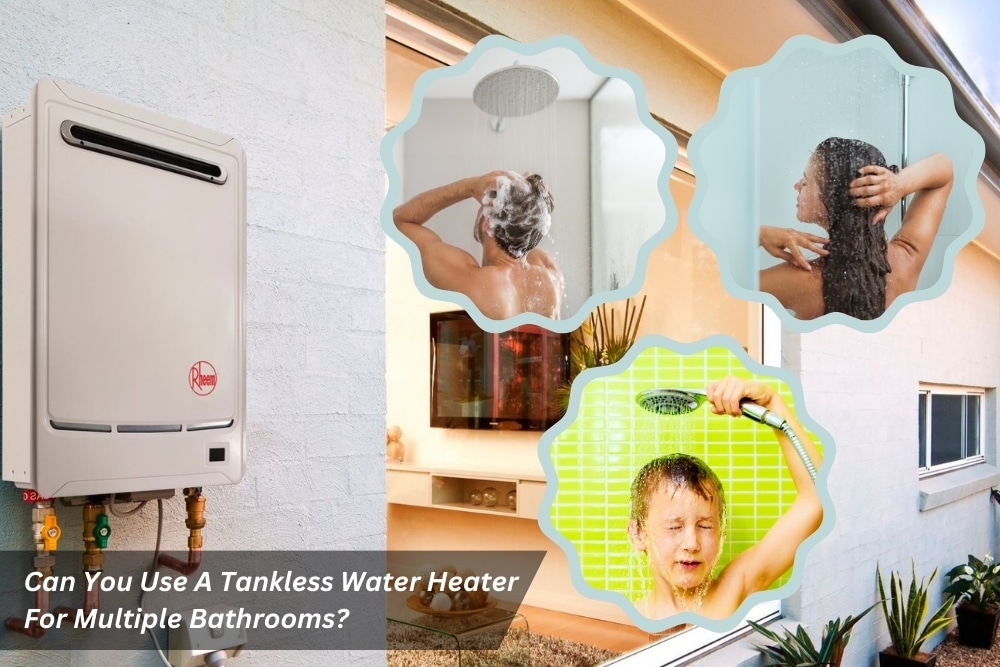Gone are the days of running out of hot water mid-shower. Tankless water heaters have become increasingly popular in recent years, offering a seemingly endless supply of hot water. But with multiple bathrooms in the house, the question arises: can a single tankless water heater handle the hot water demands of a family or group of people?
Do tankless water heaters work well for multiple bathrooms?
The answer is not a simple yes or no. Whether a tankless water heater can work well for multiple bathrooms depends on several factors, including the number of bathrooms, the size of the house, the type of fixtures, and the hot water usage habits of the occupants.
How many gallons per minute (GPM) do you need for multiple bathrooms?
The key factor in determining if a tankless water heater is suitable for multiple bathrooms is the gallons per minute (GPM) requirement. GPM refers to the amount of hot water a heater can produce per minute.
A single bathroom typically requires a GPM of 2.5-3.0. For two bathrooms, a GPM of 5-6 might be necessary. Add another bathroom, and the GPM requirement increases to 7-9. More than three bathrooms often require two tankless water heaters working in tandem or a single high-capacity unit.
Factors affecting the GPM requirement for multiple bathrooms
Several factors can affect the GPM requirement for multiple bathrooms:
- Types of fixtures: Showers and bathtubs require a higher GPM than sinks and washing machines.
- Simultaneous use: If multiple people are likely to use hot water simultaneously, the GPM requirement will be higher.
- Pipe size and distance: Older homes with smaller pipes may require a higher GPM to compensate for pressure loss.
- Desired hot water temperature: Higher desired water temperatures require a higher GPM.
Can a single tankless water heater handle multiple bathrooms?
In many cases, a single tankless water heater can handle the hot water demands of two or even three bathrooms.
However, it’s crucial to accurately assess your needs. A professional plumber can help determine the appropriate GPM requirement for your specific situation and recommend a tankless water heater that can meet your needs.
Furthermore, the key to ensuring a tankless water heater can handle your needs is choosing a model with sufficient GPM (gallons per minute). This will ensure your home has the hot water flow rate required for multiple showers, baths, and other tasks used simultaneously.
When should you consider installing multiple tankless water heaters?
If your GPM requirement is too high for a single unit, or if you have concerns about hot water availability during peak usage, installing multiple tankless water heaters might be the best solution.
Here are some situations where multiple tankless water heaters might be beneficial:
- Homes with four or more bathrooms
- Large homes with long pipe runs
- High hot water demand, such as from large families or frequent guests
- The desire for a dedicated hot water supply for specific areas, like a master bathroom
What are the benefits of using a tankless water heater for multiple bathrooms?
Tankless water heaters offer several advantages for homes with multiple bathrooms:
- Endless hot water: With no storage tank, you never have to worry about running out of hot water.
- Energy efficiency: Tankless water heaters heat water on demand, eliminating standby energy losses associated with traditional tank water heaters.
- Space saving: Tankless water heaters are compact and can be mounted on the wall, freeing up valuable floor space.
- Reduced maintenance: Tankless water heaters require less maintenance than traditional water heaters.
What are the challenges of using a tankless water heater for multiple bathrooms?
While tankless water heaters offer several benefits, there are also some challenges to consider:
- Higher upfront cost: Tankless water heaters are typically more expensive than traditional water heaters.
- Installation complexity: Installation can be more complex and require the expertise of a qualified plumber.
- Potential for fluctuating water temperature: If the GPM requirement is too high for the selected unit, the water temperature might fluctuate during simultaneous use.
What are the alternatives to using a tankless water heater for multiple bathrooms?
If you’re unsure whether a tankless water heater is the right choice for your home, here are some alternatives:
- Traditional tank water heaters: While not as energy-efficient as tankless models, they offer a lower upfront cost and a more consistent hot water supply.
- Hybrid water heaters: These combine a tank with a tankless water heater for a more efficient and reliable solution.
- Point-of-use electric tankless water heaters: These small units can be installed under sinks or near specific appliances to provide a dedicated hot water supply.
What are the installation costs for a tankless water heater for multiple bathrooms?
The installation costs for a tankless water heater for multiple bathrooms can vary depending on several factors, including:
- The number of units: Installing multiple units will naturally increase the cost.
- Type of fuel: Gas installations generally require additional plumbing and ventilation work, increasing the cost.
- Complexity of installation: Older homes or longer pipe runs might require more extensive work, driving up the costs.
It’s crucial to get quotes from multiple qualified plumbers to compare prices and ensure you get the best value for your money.
How to choose the right tankless water heater for multiple bathrooms?
If you decide that a tankless water heater is the best option for your home, choosing the right one is crucial. Here are some key factors to consider:
- GPM requirement: Ensure the unit’s GPM rating is sufficient to meet your needs.
- Fuel type: Choose between gas or electric tankless water heaters. Gas models generally offer a higher GPM but are more expensive to operate. Electric models are more energy-efficient but might not be suitable for high-demand situations.
- Features: Consider features like temperature control, recirculation pumps, and remote monitoring to enhance comfort and convenience.
- Brand and warranty: Choose a reputable brand with a good warranty to ensure reliability and peace of mind.
Rebates and Incentives
Many states and local governments offer rebates and incentives for installing energy-efficient water heaters, including tankless models. These incentives can significantly reduce the upfront cost of installation.
Conclusion
Whether or not a tankless water heater is suitable for multiple bathrooms depends on your specific needs and circumstances. By carefully considering your hot water usage, GPM requirements, and budget, you can make an informed decision that’s right for your family and your home.
Remember, consulting a professional plumber is key to determining the best solution for your hot water needs. They can assess your specific situation, recommend the appropriate tankless water heater model, and ensure proper installation for optimal performance and efficiency.
With its endless hot water supply, energy efficiency, and space-saving benefits, a tankless water heater can be a great option for those looking to upgrade their hot water system in a home with multiple bathrooms. Just make sure to carefully consider your needs and choose the right unit for your specific requirements to maximise the benefits and enjoy endless hot water for years to come.
Tired of running out of hot water in your multi-bathroom home? Sydney Hot Water Systems can help you find the perfect tankless water heater solution to ensure endless hot water for everyone, even during peak demand. With our expert installation and competitive prices, you can enjoy the benefits of energy efficiency, space savings, and endless hot water comfort. Contact us today for a free consultation and quote!


